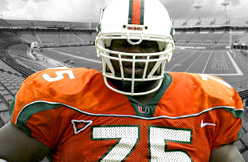At the age of 31, he’s carved out a career as one of the best big men in the NFL. He’s been to four Pro Bowls, voted a second-team All-Pro twice and been a Super Bowl winner. He’s also been a part of two other teams that have made it all the way to the big game. And in this -- his ninth season -- he’s continued to play a very high level, dominating along the line in a way that few defensive linemen can.
But is that resume enough to get Vince Wilfork to the Pro Football Hall of Fame when he retires? The one defensive constant for the Patriots since the days of their last Super Bowl title, Wilfork has been a rock in the middle for New England. Admittedly, his career isn’t over -- it’s not unrealistic to think that there will be at least one more trip to the Super Bowl, as well as another Pro Bowl berth or two -- but it’s not too early to start speculating about his chances for reaching Canton.
Since being taken 21st overall out of Miami in 2004, the 6-foot-2, 325-pounder has been a rock up front for New England, only missing six regular-season games since the beginning of 2005. This season, he has 46 tackles (32 solo), with a pair of sacks, two forced fumbles, four fumbles recovered and six passes defensed, and has been a big reason New England has spent most of the season in the top 10 when it comes to run defense. In addition, he’s played 730 of a possible 912 defensive snaps (according to Pro Football Focus), or 80 percent, a ridiculously high amount for any interior defensive lineman over the age of 30. That durability, as well as his versatility (he’s played just about every position along New England’s defensive front -- which has flipped between a four-man front and three-man front sporadically over the course of his career with the Patriots -- other than 4-3 defensive end) has made him an essential element to New England’s defensive game planning over the last nine seasons.
If we’re going to evaluate him as a possible Hall of Fame candidate, for our purposes, let’s first consider him as a defensive tackle. We won’t compare Wilfork to every other great defensive tackle who has a spot in the Hall -- the game has changed so dramatically over the years, the comparison wouldn’t be appropriate. But we can stack him up against some of the best of what the Hall calls the “modern era” defensive linemen. Of the 31 “modern era” defensive linemen who are in the Hall of Fame, 13 are pure defensive ends, a group that includes Lee Roy Selmon, Jack Youngblood, Deacon Jones and Howie Long. There are others -- like Dan Hampton and Reggie White -- who spent time at both spots.
The rest are mostly defensive tackles, but defensive tackles who have big sack totals, a group that includes Pittsburgh’s Joe Greene, Minnesota’s Alan Page and John Randle, Randy White of Dallas and Cortez Kennedy of Seattle. All of them were dominant when it came to rushing the passer. With the understanding that sack totals weren’t officially compiled prior to 1982, all of them did enough to be considered elite pass rushers: the fist four unofficially topped 100 sacks, while Kennedy, who played 11 seasons (1990-2000), finished with 58. While defensive end Michael Strahan, who was a defensive end, is a seemingly a lock as a finalist for the Hall this year, the only pure defensive tackle who is a finalist on this year’s ballot is Warren Sapp, who finished with 96.5 sacks over the course of his career, including four seasons of 10 or more sacks.
This is where Wilfork will likely suffer with Hall of Fame voters. The bottom line? The Hall likes big men, but doesn’t necessarily tend to reward big men in the middle who don’t pile up big sack numbers. Those who didn’t watch Wilfork over the course of his career will instead look at his statistical line and see a handful of sacks -- he had just the 15th of his career Monday night against Houston -- particularly when compared to some of the other defensive tackles of his era. Of course, Wilfork has played the majority of his career in a defense that didn’t call for a penetrating defensive tackle, but that won’t matter to voters who didn’t see him play on a regular basis and only look at his final numbers.
(To that end, his historical comparisons are odd. Pro Football Reference has Jerome Brown, Jumbo Elliott and Darnell Dockett listed as “similar players” -- defined by PFR as “players whose careers were similar in terms of quality and shape”. And while all three have or had carved out impressive careers for themselves, no one is talking about them as a possible Hall of Famer.)
Secondly, there’s Wilfork as a nose tackle. While he had played just about every spot on New England’s defensive front except defensive end in a four-man front (the Patriots continue to use both a four-man front and a three-man front, and he’s played nose and defensive tackle in both schemes), he came into the league as a nose tackle, and that’s where he gained his greatest measure of success. However, as Robert Mays explains here, the Hall of Fame is even less inclined to induct a nose tackle than a defensive tackle who doesn’t pile up big sack numbers. Mays mentions Kris Jenkins and Casey Hampton as two nose tackles who maybe should receive consideration from the Hall for their impact when they become eligible -- supporters of Wilfork’s possible candidacy would be wise to see how voters treat those two. Locally, all you need to do is consider the case of Fred Smerlas, a five-time Pro Bowler with the Bills, Niners and Patriots who played from 1979 to 1992. He set an NFL record for most consecutive starts by a nose tackle on some very good Buffalo teams, and while he’s been a finalist, he’s never come close to getting the call.
(In fact, according to this story from Cold, Hard Football Facts, there’s only pure nose tackle in the Hall of Fame -- Bill Willis, who played for Cleveland from 1946-53.)
However, when we’re talking about nose tackles and the Hall of Fame, it’s clear that while the game has changed, those who vote have failed to pick up on the fact that defenses have evolved as well. The current incarnation of the 3-4 defense, which really came of age in the 1980s, demanded a world-class nose tackle if a team was to execute properly. You needed a big, space eater who could control the A gap and take on two blockers at once. New England went through a few of them, including veterans like Ted Washington and Keith Traylor, before Wilfork arrived. It was soon clear that Wilfork was that guy -- the Miami product quickly learned his job wasn’t going to be about penetrating and getting sacks, but occupying blockers and freeing things up for outside linebackers and defensive ends like Mike Vrabel and Willie McGinest to get into the backfield and inside linebackers like Tedy Bruschi to shoot the gaps and pile up those tackles for loss.
To that point, it’s interesting that, with the evolution of the passing game, it’s clear now that Wilfork has now played in two distinct time frames. While 2004 wasn’t the ground-and-pound era, there was more emphasis on running the ball -- there were 19 backs that season who topped 1,000 yards. Now, with the proliferation of spread offenses, there’s a greater premium on the passing game. It would be a stretch to call them different eras, but Wilfork has managed to excel against the run and the pass, so much so that while many interior linemen are rotated out in favor of an extra defensive back or linebacker when it comes to sub defenses, he’s one of only a handful of interior linemen who can be counted on to be a three-down presence up front.
He certainly doesn’t fit the statistical mold of a Hall of Famer, but having watched Wilfork on a regular basis since he came into the league, I can tell you that so much of what Wilfork does is difficult to quantify. Occupying two and three blockers on a regular basis so that his teammates are freed up to make plays certainly isn’t as sexy as being able to pile up big sack numbers, but it’s something Wilfork does on a regular basis, and has done better than just about anyone in the league over the last nine seasons.
In the end, it appears that the biggest thing holding Wilfork and other great interior space eaters back from a call to the Hall is the outdated notion that those guys are only worthy of induction if they get after the quarterback. But just as the game has evolved and the responsibilities of the big guys has changed, the Hall of Fame voters need to alter their line of thinking when it comes to evaluating big guys like Wilfork. If that happens, they should start measuring him for a yellow blazer the second he calls it a career.

(weei.com)



